
Robert Fulton was an American engineer and inventor who is widely credited with developing the world's first commercially successful steamboat, the North River Steamboat. In 1807, that steamboat traveled on the Hudson River with passengers from New York City to Albany and back again, a round trip of 300 miles (480 km), in 62 hours. The success of his steamboat changed river traffic and trade on major American rivers.
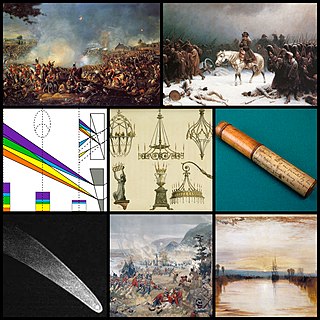
The 1810s was a decade of the Gregorian calendar that began on January 1, 1810, and ended on December 31, 1819.

Brownsville is a borough in Fayette County, Pennsylvania, United States, first settled in 1785 as the site of a trading post a few years after the pacification of the Iroquois enabled a post-Revolutionary war resumption of westward migration. The Trading Post soon became a tavern and Inn, and was soon receiving emigrants heading west as it was located above the cut bank overlooking first ford that could be reached to those descending from the Mountains. Brownsville is located 40 miles (64 km) south of Pittsburgh along the east bank of the Monongahela River.
Gibbons v. Ogden, 22 U.S. 1 (1824), was a landmark decision in which the Supreme Court of the United States held that the power to regulate interstate commerce, granted to Congress by the Commerce Clause of the United States Constitution, encompassed the power to regulate navigation. The case was argued by some of America's most admired and capable attorneys at the time. Exiled Irish patriot Thomas Addis Emmet and Thomas J. Oakley argued for Ogden, while U.S. Attorney General William Wirt and Daniel Webster argued for Gibbons.

A steamboat is a boat that is propelled primarily by steam power, typically driving propellers or paddlewheels. Steamboats sometimes use the prefix designation SS, S.S. or S/S or PS ; however, these designations are most often used for steamships.
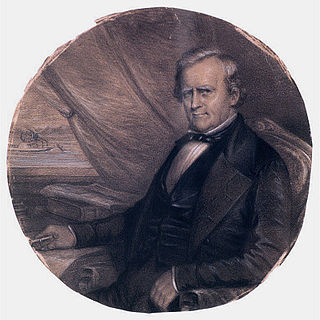
Henry Miller Shreve was the American inventor and steamboat captain who opened the Mississippi, Ohio, and Red rivers to steamboat navigation. Shreveport, Louisiana, is named in his honor.

The Monongahela Railway was a coal-hauling short line railroad in Pennsylvania and West Virginia in the United States. It was jointly controlled originally by the Pennsylvania Railroad, New York Central subsidiary Pittsburgh and Lake Erie Railroad, and the Baltimore and Ohio Railroad, with NYC and PRR later succeeded by Penn Central Transportation. The company operated its own line until it was merged into Conrail on May 1, 1993.
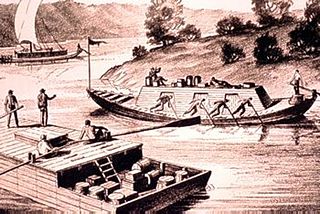
A keelboat is a riverine cargo-capable working boat, or a small- to mid-sized recreational sailing yacht. The boats in the first category have shallow structural keels, and are nearly flat-bottomed and often used leeboards if forced in open water, while modern recreational keelboats have prominent fixed fin keels, and considerable draft. The two terms may draw from cognate words with different final meaning.
Daniel French (1770–1853), a "Yankee" inventor, was born in Berlin, Connecticut. From an early age French strove to become a "mechanician," an artisan trained in the theory of mechanics and skilled in the working of metals at increasing levels of precision. His friend Oliver Evans, an accomplished engineer, described French as an "original and ingenious inventor." French's most significant invention was the horizontally mounted, high-pressure, non-condensing, directly connected steam engine for mills, boats, etc. French was awarded a patent for his steam engine in 1809. This type of engine became standard on the western steamboat.
Nicholas Jacobus Roosevelt or Nicholas James Roosevelt was an American inventor, a major investor in Upstate New York land, and a member of the Roosevelt family. His primary invention was to introduce vertical paddle wheels for steamboats.
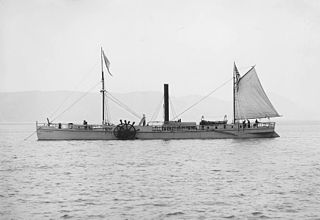
The North River Steamboat or North River, colloquially known as the Clermont, is widely regarded as the world's first vessel to demonstrate the viability of using steam propulsion for commercial water transportation. Built in 1807, the North River Steamboat operated on the Hudson River – at that time often known as the North River – between New York City and Albany, New York. She was built by the wealthy investor and politician Robert Livingston and inventor and entrepreneur Robert Fulton (1765–1815).

The steamboat Enterprise demonstrated for the first time by her epic 2,200-mile (3,500 km) voyage from New Orleans to Brownsville, Pennsylvania that steamboat commerce was practical on the Mississippi River and its tributaries.
Steamboats operated on the Wenatchee Reach of the Columbia River from the late 1880s to 1915. The main base of operations was Wenatchee, Washington, located at the confluence of the Wenatchee and Columbia Rivers, 465 miles (748 km) from the mouth of the river. Operations were mainly between Wenatchee and Bridgeport. Rapids below Wenatchee and above Bridgeport prevented safe navigation.

New Orleans was the first steamboat on the western waters of the United States. Owned by Robert Fulton and Robert R. Livingston, and built by Nicholas Roosevelt, its 1811–1812 voyage from Pittsburgh, Pennsylvania, to New Orleans, Louisiana, on the Ohio and Mississippi rivers ushered in the era of commercial steamboat navigation on the western and mid-western continental rivers.
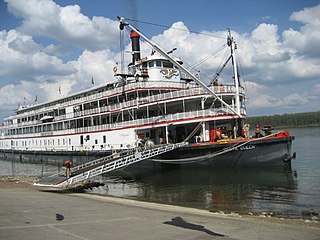
Steamboats played a major role in the 19th-century development of the Mississippi River and its tributaries, allowing practical large-scale transport of passengers and freight both up- and down-river. Using steam power, riverboats were developed during that time which could navigate in shallow waters as well as upriver against strong currents. After the development of railroads, passenger traffic gradually switched to this faster form of transportation, but steamboats continued to serve Mississippi River commerce into the early 20th century. A small number of steamboats are still used for tourist excursions in the 21st century.
Israel Gregg was the first captain of the historic steamboat Enterprise. From June to December 1814, Israel Gregg commanded the Enterprise during two voyages from Louisville, Kentucky to Pittsburgh, Pennsylvania that were performed against strong currents of the Ohio River. With these voyages Israel Gregg and the Enterprise demonstrated for the first time that steamboat commerce was practical on the Ohio River.
Redstone Creek is a historically important widemouthed canoe and river boat-navigable brook-sized tributary stream of the Monongahela River in Fayette County, Pennsylvania. The creek is 28.4 miles (45.7 km) long, running from headwaters on Chestnut Ridge north through the city of Uniontown and reaching the Monongahela at Brownsville. Located in a 1/4-mile-wide valley with low streambanks, the site was ideal for ship building in a region geologically most often characterized by steep-plunging relatively inaccessible banks — wide enough to launch and float several large boats, and indeed steamboats after 1811, and slow-moving enough to provide good docks and parking places while craft were outfitting.
Thomas Brown, was an American colonial era husbandman, businessman, and land speculator. Along with his brother Basil, he acquired the bulk of the (Brownsville) lands towards the end of the American Revolution from Thomas Cresap(Cresap's War, Lord Dunmore's War), early enough to sell plots to Jacob Bowman in 1780 and Jacob Yoder who respectively made business firsts in 1780 and 1782; Jacob Bowman founded a trading post and tavern. Yoder got in a crop big enough to ship to New Orleans and invented the flat boat on Redstone Creek, inaugurating the water craft construction businesses which made the town an industrial powerhouse for the next seventy years.
The steamboat Comet was the second steamboat to navigate the Ohio and Mississippi rivers. Comet's owner was Daniel D. Smith and she was launched in 1813 at Pittsburgh, Pennsylvania. With an engine and power train designed and built by Daniel French, the Comet was the first of the Western steamboats to be powered by a horizontal high-pressure engine with its piston rod connected to a stern paddle wheel. Smith was the first to defy the steamboat monopoly in Orleans Territory granted to Robert R. Livingston and Robert Fulton.

Elisha Hunt (1779–1873) was the principal entrepreneur behind the Monongahela and Ohio Steam Boat Company that built the historic steamboat Enterprise.
 "Enterprise on her fast trip to Louisville, 1815"
"Enterprise on her fast trip to Louisville, 1815"


















